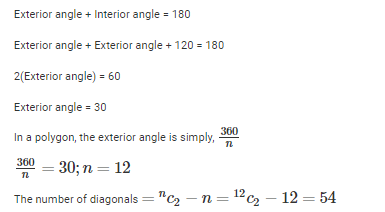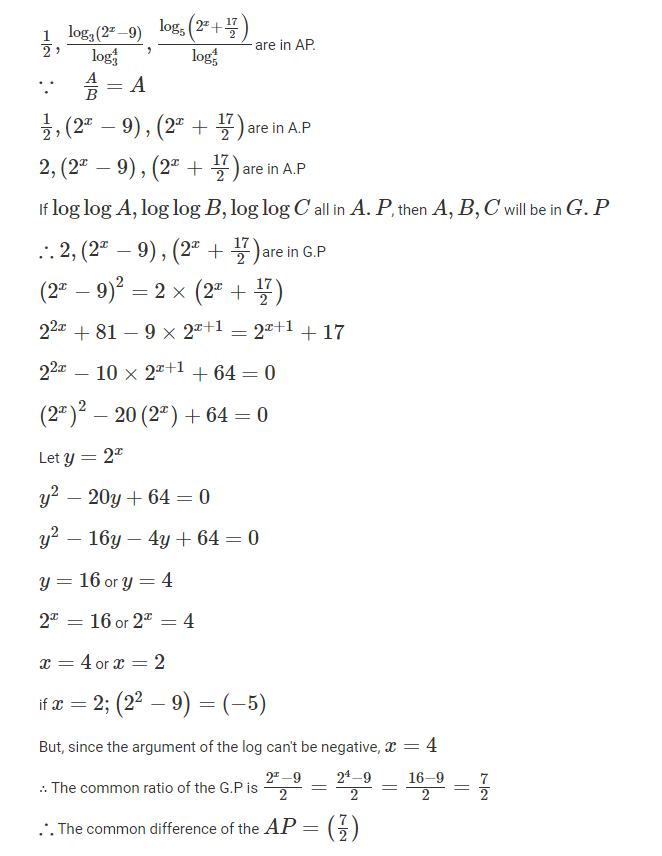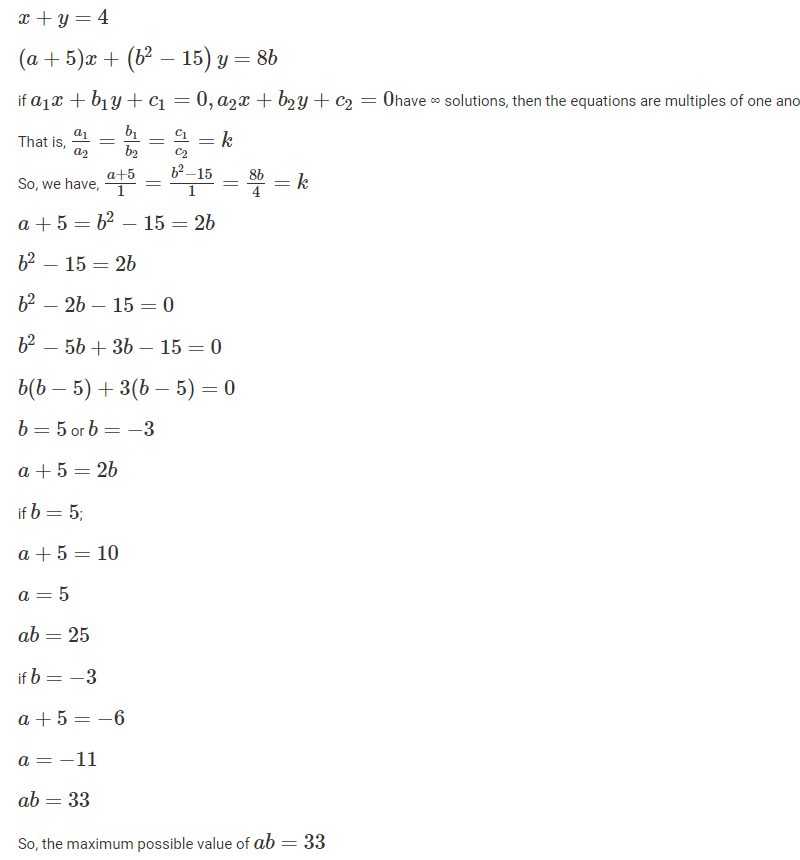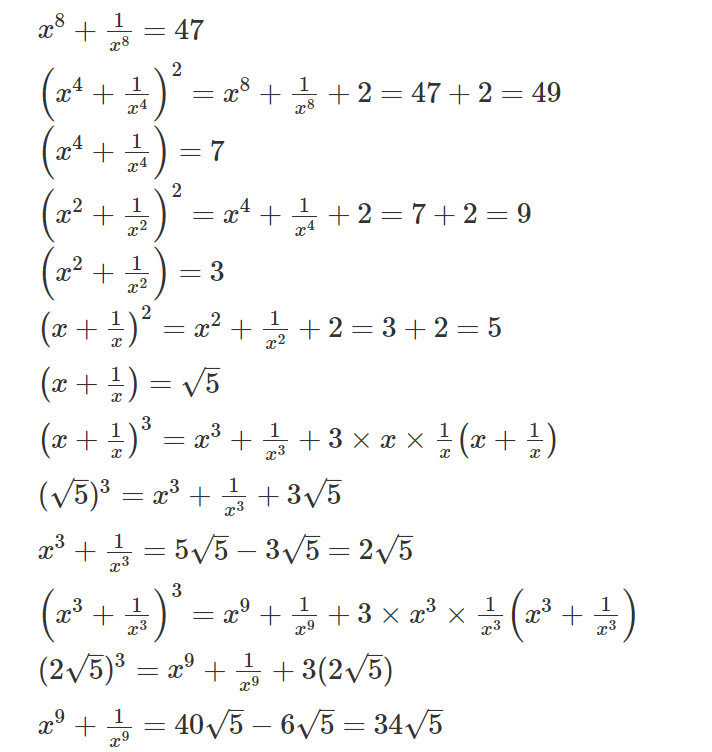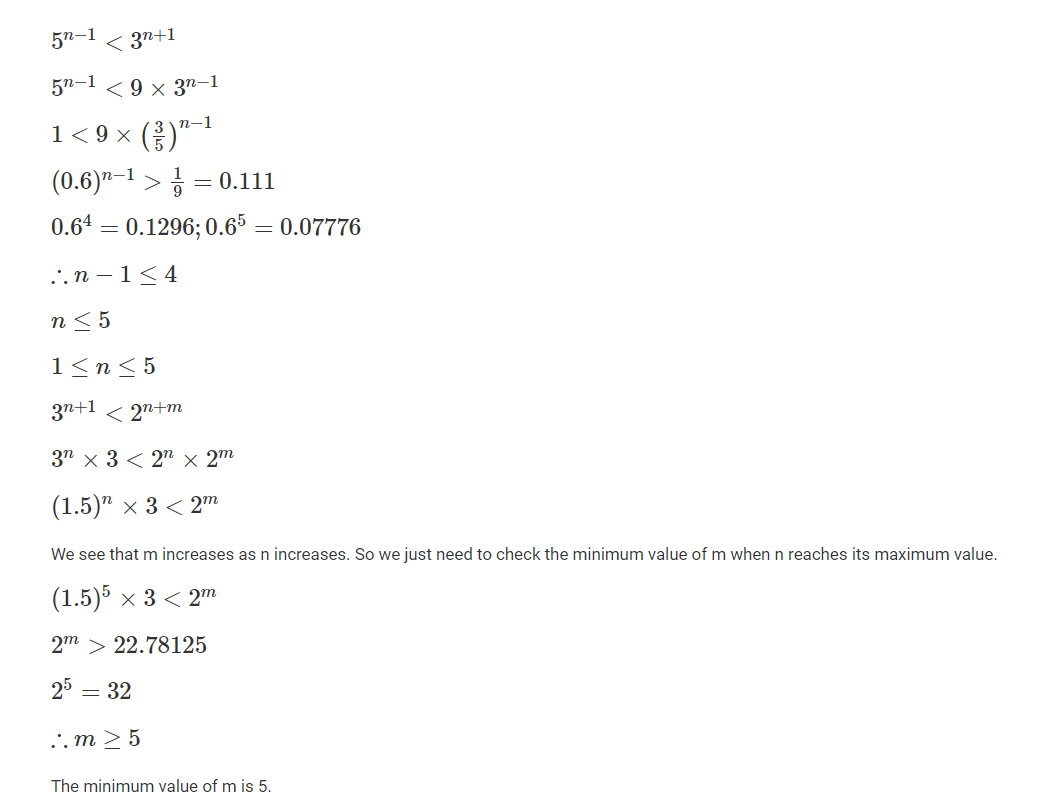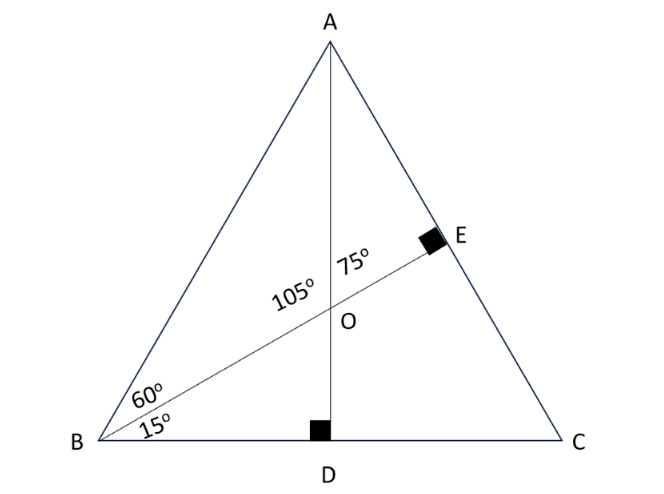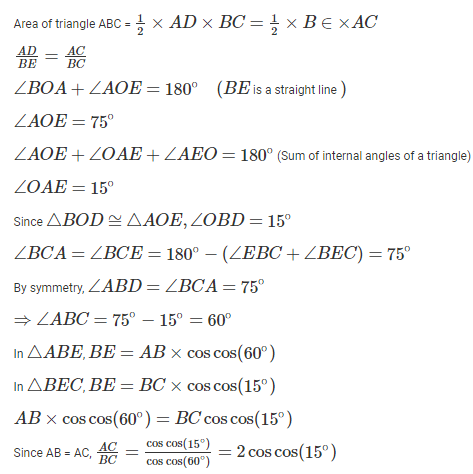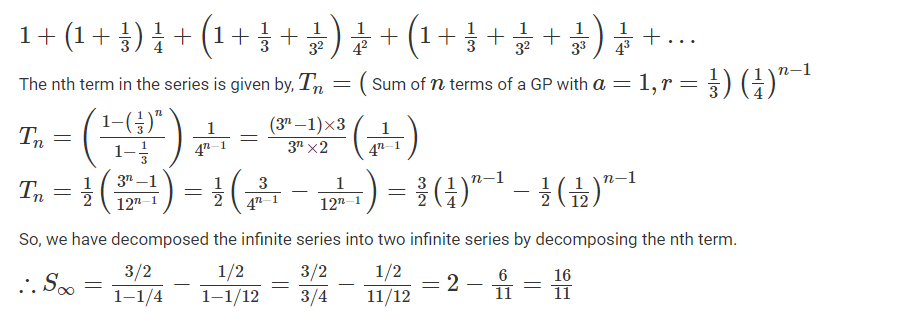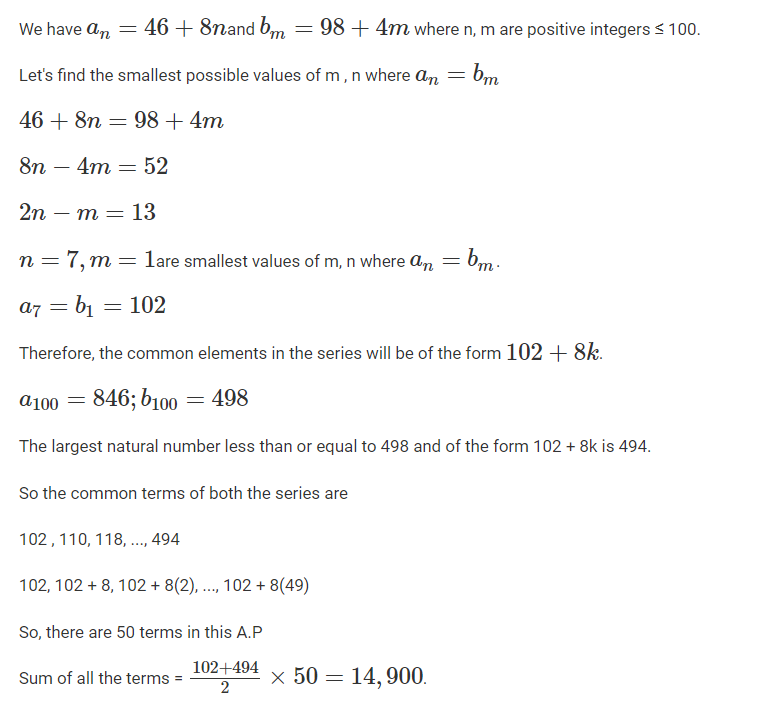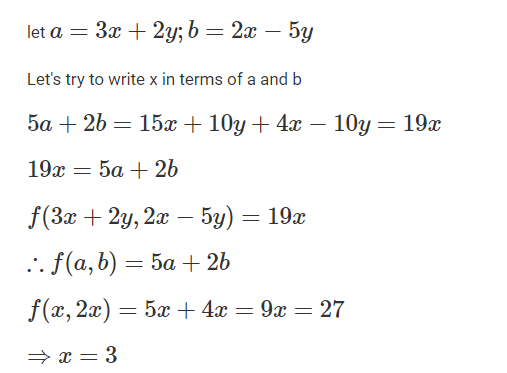Live Updates
• CATKing has launched new chat bot.

• New video on Logs has been released.
495
Learners
asked the doubt

Previous Year Questions
The passage below is accompanied by four questions. Based on the passage, choose the best answer for each question.
The biggest challenge [The Nutmeg's Curse by Ghosh] throws down is to the prevailing understanding of when the climate crisis started. Most of us have accepted . . . that it started with the widespread use of coal at the beginning of the Industrial Age in the 18th century and worsened with the mass adoption of oil and natural gas in the 20th. Ghosh takes this history at least three centuries back, to the start of European colonialism in the 15th century. He [starts] the book with a 1621 massacre by Dutch invaders determined to impose a monopoly on nutmeg cultivation and trade in the Banda islands in today's Indonesia.
Not only do the Dutch systematically depopulate the islands through genocide, they also try their best to bring nutmeg cultivation into plantation mode. These are the two points to which Ghosh returns through examples from around the world. One, how European colonialists decimated not only indigenous populations but also indigenous understanding of the relationship between humans and Earth. Two, how this was an invasion not only of humans but of the Earth itself, and how this continues to the present day by looking at nature as a 'resource' to exploit. . . . We know we are facing more frequent and more severe heatwaves, storms, floods, droughts and wildfires due to climate change. We know our expansion through deforestation, dam building, canal cutting – in short, terraforming, the word Ghosh uses – has brought us repeated disasters . . .
Are these the responses of an angry Gaia who has finally had enough? By using the word 'curse' in the title, the author makes it clear that he thinks so. I use the pronoun 'who' knowingly, because Ghosh has quoted many non-European sources to enquire into the relationship between humans and the world around them so that he can question the prevalent way of looking at Earth as an inert object to be exploited to the maximum. As Ghosh's text, notes and bibliography show once more, none of this is new. There have always been challenges to the way European colonialists looked at other civilisations and at Earth. It is just that the invaders and their myriad backers in the fields of economics, politics, anthropology, philosophy, literature, technology, physics, chemistry, biology have dominated global intellectual discourse. . . .
There are other points of view that we can hear today if we listen hard enough. Those observing global climate negotiations know about the Latin American way of looking at Earth as Pachamama (Earth Mother). They also know how such a framing is just provided lip service and is ignored in the substantive portions of the negotiations. In The Nutmeg's Curse, Ghosh explains why. He shows the extent of the vested interest in the oil economy – not only for oil-exporting countries, but also for a superpower like the US that controls oil drilling, oil prices and oil movement around the world. Many of us know power utilities are sabotaging decentralised solar power generation today because it hits their revenues and control. And how the other points of view are so often drowned out.
On the basis of information in the passage, which one of the following is NOT a reason for the failure of policies seeking to address climate change?
Video Explanation

Explanatory Answer
Only option C does not relate to why policies seeking to address climate change fail.
The reasons mentioned in options A and D are stated in the last few lines: 'He shows the extent of the vested interest in the oil economy – not only for oil-exporting countries, but also for a superpower like the US that controls oil drilling, oil prices and oil movement around the world. Many of us know power utilities are sabotaging decentralised solar power generation today because it hits their revenues and control'.
Option B, too, is mentioned:'There have always been challenges to the way European colonialists looked at other civilisations and at Earth. It is just that the invaders and their myriad backers...have dominated global intellectual discourse. . . . There are other points of view that we can hear today if we listen hard enough...'
Which one of the following best explains the primary purpose of the discussion of the colonisation of the Banda islands in "The Nutmeg's Curse"?
Video Explanation

Explanatory Answer
Note the context in which the passage takes the case of Banda islands: 'The biggest challenge [The Nutmeg's Curse by Ghosh] throws down is to the prevailing understanding of when the climate crisis started. Most of us have accepted...that it started with the widespread use of coal..Ghosh takes this history at least three centuries back, to the start of European colonialism in the 15th century. He [starts] the book with a 1621 massacre by Dutch invaders determined to impose a monopoly on nutmeg cultivation and trade in the Banda islands in today's Indonesia.'
So, the primary purpose of the discussion of the colonisation of the Banda islands in "The Nutmeg's Curse" is to illustrate how colonialism represented and perpetuated the mindset that has led to climate change.
All of the following can be inferred from the reviewer's discussion of "The Nutmeg's Curse", EXCEPT:
Video Explanation

Explanatory Answer
Option A is the exact opposite of what the passage states. The passage explains how European colonialists influenced the prevalent way of looking at Earth as a 'resource' to exploit. Though there have been challenges to this way of thinking, the passage says, 'the invaders and their myriad backers in the fields of economics, politics, anthropology, philosophy, literature, technology, physics, chemistry, biology have dominated global intellectual discourse.' Option A cannot be inferred; this is the correct answer choice.
All other options relate to key ideas that can be inferred from the passage..
Which one of the following, if true, would make the reviewer's choice of the pronoun "who" for Gaia inappropriate?
Video Explanation

Explanatory Answer
Note the reason stated by the reviewer for the choice of the pronoun, "who":'I use the pronoun 'who' knowingly, because Ghosh has quoted many non-European sources to enquire into the relationship between humans and the world around them..' The reviewer justifies his choice based on the understanding of Earth as a living entity by non-European societies. So, if option C were true, it would make the reviewer's choice of the pronoun "who" for Gaia inappropriate.
The passage below is accompanied by four questions. Based on the passage, choose the best answer for each question.
Steven Pinker's new book, "Rationality: What It Is, Why It Seems Scarce, Why It Matters," offers a pragmatic dose of measured optimism, presenting rationality as a fragile but achievable ideal in personal and civic life. . . . Pinker's ambition to illuminate such a crucial topic offers the welcome prospect of a return to sanity. . . . It's no small achievement to make formal logic, game theory, statistics and Bayesian reasoning delightful topics full of charm and relevance.
It's also plausible to believe that a wider application of the rational tools he analyzes would improve the world in important ways. His primer on statistics and scientific uncertainty is particularly timely and should be required reading before consuming any news about the [COVID] pandemic. More broadly, he argues that less media coverage of shocking but vanishingly rare events, from shark attacks to adverse vaccine reactions, would help prevent dangerous overreactions, fatalism and the diversion of finite resources away from solvable but less-dramatic issues, like malnutrition in the developing world.
It's a reasonable critique, and Pinker is not the first to make it. But analyzing the political economy of journalism — its funding structures, ownership concentration and increasing reliance on social media shares — would have given a fuller picture of why so much coverage is so misguided and what we might do about it.
Pinker's main focus is the sort of conscious, sequential reasoning that can track the steps in a geometric proof or an argument in formal logic. Skill in this domain maps directly onto the navigation of many real-world problems, and Pinker shows how greater mastery of the tools of rationality can improve decision-making in medical, legal, financial and many other contexts in which we must act on uncertain and shifting information. . . .
Despite the undeniable power of the sort of rationality he describes, many of the deepest insights in the history of science, math, music and art strike their originators in moments of epiphany. From the 19th-century chemist Friedrich August Kekulé's discovery of the structure of benzene to any of Mozart's symphonies, much extraordinary human achievement is not a product of conscious, sequential reasoning. Even Plato's Socrates — who anticipated many of Pinker's points by nearly 2,500 years, showing the virtue of knowing what you do not know and examining all premises in arguments, not simply trusting speakers' authority or charisma — attributed many of his most profound insights to dreams and visions. Conscious reasoning is helpful in sorting the wheat from the chaff, but it would be interesting to consider the hidden aquifers that make much of the grain grow in the first place.
The role of moral and ethical education in promoting rational behavior is also underexplored. Pinker recognizes that rationality "is not just a cognitive virtue but a moral one." But this profoundly important point, one subtly explored by ancient Greek philosophers like Plato and Aristotle, doesn't really get developed. This is a shame, since possessing the right sort of moral character is arguably a precondition for using rationality in beneficial ways.
The author refers to the ancient Greek philosophers to:
Video Explanation

Explanatory Answer
Easy question. Refer to the lines, 'The role of moral and ethical education in promoting rational behavior is also underexplored. Pinker recognizes that rationality "is not just a cognitive virtue but a moral one." But this profoundly important point, one subtly explored by ancient Greek philosophers like Plato and Aristotle, doesn't really get developed'. Option B is the correct choice.
The author mentions Kekulé's discovery of the structure of benzene and Mozart's symphonies to illustrate the point that:
Video Explanation

Explanatory Answer
Note the context in which the author mentions Kekulé's discovery of the structure of benzene and Mozart's symphonies: 'Despite the undeniable power of the sort of rationality he describes, many of the deepest insights in the history of science, math, music and art strike their originators in moments of epiphany. From the 19th-century chemist Friedrich August Kekulé's discovery of the structure of benzene to any of Mozart's symphonies, much extraordinary human achievement is not a product of conscious, sequential reasoning'. Here, the author is making the point that great innovations can stem from flashes of intuition and are not always propelled by logical thinking. Option A is the correct choice.
According to the author, for Pinker as well as the ancient Greek philosophers, rational thinking involves all of the following EXCEPT:
Video Explanation

Explanatory Answer
The passage states that unlike Pinker, whose main focus is on conscious, sequential reasoning, Socrates, while affirming the virtue of conscious, sequential reasoning, also 'attributed many of his most profound insights to dreams and visions'. Option C is the correct answer choice as the views of Pinker and ancient Greek philosophers differ on this point.
For both Pinker as well as the ancient Greek philosophers,the ability to reason logically encompasses an ethical and moral dimension: 'Pinker recognizes that rationality "is not just a cognitive virtue but a moral one." But this profoundly important point, one subtly explored by ancient Greek philosophers...'So, option A is true.
According to the passage, Socrates 'anticipated many of Pinker's points by nearly 2,500 years, showing the virtue of knowing what you do not know and examining all premises in arguments, not simply trusting speakers' authority or charisma'. So, options B and D are true.
The author endorses Pinker's views on the importance of logical reasoning as it:
Video Explanation

Explanatory Answer
Note the author's comments on Pinker's views on the importance of logical reasoning: 'Skill in this domain maps directly onto the navigation of many real-world problems, and Pinker shows how greater mastery of the tools of rationality can improve decision-making in medical, legal, financial and many other contexts in which we must act on uncertain and shifting information'. So, option A is the correct answer choice.
The passage below is accompanied by four questions. Based on the passage, choose the best answer for each question.
In 2006, the Met [art museum in the US] agreed to return the Euphronios krater, a masterpiece Greek urn that had been a museum draw since 1972. In 2007, the Getty [art museum in the US] agreed to return 40 objects to Italy, including a marble Aphrodite, in the midst of looting scandals. And in December, Sotheby's and a private owner agreed to return an ancient Khmer statue of a warrior, pulled from auction two years before, to Cambodia.
Cultural property, or patrimony, laws limit the transfer of cultural property outside the source country's territory, including outright export prohibitions and national ownership laws. Most art historians, archaeologists, museum officials and policymakers portray cultural property laws in general as invaluable tools for counteracting the ugly legacy of Western cultural imperialism.
During the late 19th and early 20th century — an era former Met director Thomas Hoving called "the age of piracy" — American and European art museums acquired antiquities by hook or by crook, from grave robbers or souvenir collectors, bounty from digs and ancient sites in impoverished but art-rich source countries. Patrimony laws were intended to protect future archaeological discoveries against Western imperialist designs. . . .
I surveyed 90 countries with one or more archaeological sites on UNESCO's World Heritage Site list, and my study shows that in most cases the number of discovered sites diminishes sharply after a country passes a cultural property law. There are 222 archaeological sites listed for those 90 countries. When you look into the history of the sites, you see that all but 21 were discovered before the passage of cultural property laws. . . .
Strict cultural patrimony laws are popular in most countries. But the downside may be that they reduce incentives for foreign governments, nongovernmental organizations and educational institutions to invest in overseas exploration because their efforts will not necessarily be rewarded by opportunities to hold, display and study what is uncovered. To the extent that source countries can fund their own archaeological projects, artifacts and sites may still be discovered. . . . The survey has far-reaching implications. It suggests that source countries, particularly in the developing world, should narrow their cultural property laws so that they can reap the benefits of new archaeological discoveries, which typically increase tourism and enhance cultural pride. This does not mean these nations should abolish restrictions on foreign excavation and foreign claims to artifacts.
China provides an interesting alternative approach for source nations eager for foreign archaeological investment. From 1935 to 2003, China had a restrictive cultural property law that prohibited foreign ownership of Chinese cultural artifacts. In those years, China's most significant archaeological discovery occurred by chance, in 1974, when peasant farmers accidentally uncovered ranks of buried terra cotta warriors, which are part of Emperor Qin's spectacular tomb system.
In 2003, the Chinese government switched course, dropping its cultural property law and embracing collaborative international archaeological research. Since then, China has nominated 11 archaeological sites for inclusion in the World Heritage Site list, including eight in 2013, the most ever for China.
From the passage we can infer that the author is likely to advise poor, but archaeologically-rich source countries to do all of the following, EXCEPT:
Video Explanation

Explanatory Answer
The author argues that strict cultural patrimony laws reduce incentives for foreign governments, nongovernmental organizations and educational institutions to invest in overseas exploration. So, the author suggests, source countries, particularly in the developing world, should narrow their cultural property laws so that they can reap the benefits of new archaeological discoveries. The author also substantiates this point with the example of China, which has dropped its cultural property law and embraced collaborative international archaeological research, thereby greatly increasing the number of archaeological sites for inclusion in the World Heritage Site list.
Options A, B and C relate to the author's ideas stated in the passage.
The author is unlikely to advise poor source countries to fund institutes in other countries. So, option D is the correct answer choice.
It can be inferred from the passage that archaeological sites are considered important by some source countries because they:
Video Explanation

Explanatory Answer
Note the lines, 'The survey has far-reaching implications. It suggests that source countries, particularly in the developing world, should narrow their cultural property laws so that they can reap the benefits of new archaeological discoveries, which typically increase tourism and enhance cultural pride'. So, it can be inferred from the passage that archaeological sites are considered important by some source countries because they give a boost to the tourism sector. Option A is the correct answer choice.
Which one of the following statements, if true, would undermine the central idea of the passage?
Video Explanation

Explanatory Answer
The central idea of the passage is that strict culture patrimony laws reduce incentives for foreign investment in archaeological research, thereby depriving poor, but archaeologically-rich source countries of the benefits of new archaeological research. If UNESCO finances archaeological research in poor, but archaeologically-rich source countries then there would be no need for these countries to drop strict cultural property laws. So, option D, if true, would undermine the central idea of the passage.
The author is specifically talking about the case of poor, but archaeologically-rich source countries. Option A, even if true, would not undermine the central idea of the passage.
Options B and C are not related to the central idea, which is about the need to drop strict cultural property laws.
Which one of the following statements best expresses the paradox of patrimony laws?
Video Explanation

Explanatory Answer
Easy question, relating to the key point made by the author in the passage. The author's study shows that in most cases, the number of discovered sites diminishes sharply after a country passes a cultural property law. Therein lies the paradox. Though patrimony laws were aimed at protecting cultural property, they instead reduced new archaeological discoveries.
The passage below is accompanied by four questions. Based on the passage, choose the best answer for each question.
Understanding romantic aesthetics is not a simple undertaking for reasons that are internal to the nature of the subject. Distinguished scholars, such as Arthur Lovejoy, Northrop Frye and Isaiah Berlin, have remarked on the notorious challenges facing any attempt to define romanticism. Lovejoy, for example, claimed that romanticism is "the scandal of literary history and criticism" . . . The main difficulty in studying the romantics, according to him, is the lack of any "single real entity, or type of entity" that the concept "romanticism" designates. Lovejoy concluded, "the word 'romantic' has come to mean so many things that, by itself, it means nothing" . . .
The more specific task of characterizing romantic aesthetics adds to these difficulties an air of paradox. Conventionally, "aesthetics" refers to a theory concerning beauty and art or the branch of philosophy that studies these topics. However, many of the romantics rejected the identification of aesthetics with a circumscribed domain of human life that is separated from the practical and theoretical domains of life. The most characteristic romantic commitment is to the idea that the character of art and beauty and of our engagement with them should shape all aspects of human life. Being fundamental to human existence, beauty and art should be a central ingredient not only in a philosophical or artistic life, but also in the lives of ordinary men and women. Another challenge for any attempt to characterize romantic aesthetics lies in the fact that most of the romantics were poets and artists whose views of art and beauty are, for the most part, to be found not in developed theoretical accounts, but in fragments, aphorisms and poems, which are often more elusive and suggestive than conclusive.
Nevertheless, in spite of these challenges the task of characterizing romantic aesthetics is neither impossible nor undesirable, as numerous thinkers responding to Lovejoy's radical skepticism have noted. While warning against a reductive definition of romanticism, Berlin, for example, still heralded the need for a general characterization: "[Although] one does have a certain sympathy with Lovejoy's despair...[he is] in this instance mistaken. There was a romantic movement...and it is important to discover what it is" . . .
Recent attempts to characterize romanticism and to stress its contemporary relevance follow this path. Instead of overlooking the undeniable differences between the variety of romanticisms of different nations that Lovejoy had stressed, such studies attempt to characterize romanticism, not in terms of a single definition, a specific time, or a specific place, but in terms of "particular philosophical questions and concerns" . . .
While the German, British and French romantics are all considered, the central protagonists in the following are the German romantics. Two reasons explain this focus: first, because it has paved the way for the other romanticisms, German romanticism has a pride of place among the different national romanticisms . . . Second, the aesthetic outlook that was developed in Germany roughly between 1796 and 1801–02 — the period that corresponds to the heyday of what is known as "Early Romanticism" . . .— offers the most philosophical expression of romanticism since it is grounded primarily in the epistemological, metaphysical, ethical, and political concerns that the German romantics discerned in the aftermath of Kant's philosophy.
According to the romantics, aesthetics:
Video Explanation

Explanatory Answer
Note the lines, 'The most characteristic romantic commitment is to the idea that the character of art and beauty and of our engagement with them should shape all aspects of human life. Being fundamental to human existence, beauty and art should be a central ingredient not only in a philosophical or artistic life, but also in the lives of ordinary men and women.' So, according to the romantics, aesthetics permeates all aspects of human life, philosophical and mundane. Option B is the correct choice.
Which one of the following statements is NOT supported by the passage?
Video Explanation

Explanatory Answer
Option A is the opposite of what the passage states: 'Recent attempts to characterize romanticism and to stress its contemporary relevance follow this path. Instead of overlooking the undeniable differences between the variety of romanticisms of different nations that Lovejoy had stressed, such studies..." So, option A is not supported by the passage.
Option B is true, based on the line:'Another challenge for any attempt to characterize romantic aesthetics lies in the fact that most of the romantics were poets and artists whose views of art and beauty are, for the most part, to be found not in developed theoretical accounts, but in fragments, aphorisms and poems...'
Option C is true, too: 'However, many of the romantics rejected the identification of aesthetics with a circumscribed domain of human life that is separated from the practical and theoretical domains of life.'
Option D is true, based on the line,'Nevertheless, in spite of these challenges the task of characterizing romantic aesthetics is neither impossible nor undesirable, as numerous thinkers responding to Lovejoy's radical skepticism have noted.'
The main difficulty in studying romanticism is the:
Video Explanation

Explanatory Answer
Easy question. Note the line, ' The main difficulty in studying the romantics, according to him, is the lack of any "single real entity, or type of entity" that the concept "romanticism" designates.' So, according to the passage, the main difficulty in studying romanticism is the lack of clear conceptual contours of the domain. Option D.
According to the passage, recent studies on romanticism avoid "a single definition, a specific time, or a specific place" because they:
Video Explanation

Explanatory Answer
Option D is the correct choice, based on the lines, 'While warning against a reductive definition of romanticism, Berlin, for example, still heralded the need for a general characterization: "[Although] one does have a certain sympathy with Lovejoy's despair...[he is] in this instance mistaken. There was a romantic movement...and it is important to discover what it is"...'
There is a sentence that is missing in the paragraph below. Look at the paragraph and decide where (option 1, 2, 3, or 4) the following sentence would best fit.
Sentence: For theoretical purposes, arguments may be considered as freestanding entities, abstracted from their contexts of use in actual human activities.
Paragraph : ___(1)___. An argument can be defined as a complex symbolic structure where some parts, known as the premises, offer support to another part, the conclusion. Alternatively, an argument can be viewed as a complex speech act consisting of one or more acts of premising (which assert propositions in favor of the conclusion), an act of concluding, and a stated or implicit marker ("hence", "therefore") that indicates that the conclusion follows from the premises.___(2)___. The relation of support between premises and conclusion can be cashed out in different ways: the premises may guarantee the truth of the conclusion, or make its truth more probable; the premises may imply the conclusion; the premises may make the conclusion more acceptable (or assertible).___(3)___. But depending on one's explanatory goals, there is also much to be gained from considering arguments as they in fact occur in human communicative practices.___(4)___.
Video Explanation

Explanatory Answer
Option 3 is the most logical place to fit in the given sentence. The given sentence says that for 'theoretical purposes', arguments may be considered as freestanding entities abstracted from their contexts. The line after option 3 puts forth the alternative view: depending on explanatory goals, there is also much to be gained from considering arguments as they in fact occur in human communicative practices.
There is a sentence that is missing in the paragraph below. Look at the paragraph and decide where (option 1, 2, 3, or 4) the following sentence would best fit.
Sentence: Beyond undermining the monopoly of the State on the use of force, armed conflict also creates an environment that can enable organized crime to prosper.
Paragraph: ___(1)___. Linkages between illicit arms, organized crime, and armed conflict can reinforce one another while also escalating and prolonging violence and eroding governance.___(2)___. Financial gains from crime can lengthen or intensify armed conflicts by creating revenue streams for non-State armed groups (NSAGs).___(3)___. In this context, when hostilities cease and parties to a conflict move towards a peaceful resolution, the widespread availability of surplus arms and ammunition can contribute to a situation of 'criminalized peace' that obstructs sustainable peacebuilding efforts.___(4)___.
Video Explanation

Explanatory Answer
The given sentence starts with 'beyond undermining the monopoly of the State on the use of force'. So, the sentence before it must relate to this point. We see that the sentence before option 3 talks about non-State armed groups. So, option 3 is the best place to fit in the given sentence.
Five jumbled up sentences (labelled 1, 2, 3, 4 and 5), related to a topic, are given below. Four of them can be put together to form a coherent paragraph. Identify the odd sentence and key in the number of that sentence as your answer.
1. Although hard skills have traditionally ruled the roost, some companies are moving away from choosing prospective hires based on technical abilities alone.
2. Companies are shaking off the old definition of an ideal candidate and ditching the idea of looking for the singularly perfect candidate altogether.
3. Now, some job descriptions are frequently asking for candidates to demonstrate soft skills, such as leadership or teamwork.
4. That's not to say that practical know-how is no longer required – some jobs still call for highly specific expertise
5. The move towards prioritising soft skills "is a natural response to three years of the pandemic" says a senior recruiter at Cenlar FSB.
Video Explanation

Explanatory Answer
All sentences other than sentence 2 relate to skills- hard and soft skills- companies are looking for in prospective hires. Sentence 2, which talks about the ideal/perfect candidate, is the odd one out.
If the sentences were to be put in a paragraph, 1 would be the opening sentence. 1 says some companies are moving away from choosing prospective hires based on technical abilities alone. 3 follows 1, stating that some job descriptions are frequently asking for candidates to demonstrate soft skills. 5 adds to 3 and 4 concludes the paragraph.
Five jumbled up sentences (labelled 1, 2, 3, 4 and 5), related to a topic, are given below. Four of them can be put together to form a coherent paragraph. Identify the odd sentence and key in the number of that sentence as your answer.
1. Boa Senior, who lived through the 2004 tsunami, the Japanese occupation and diseases brought by British settlers, was the last native of the island chain who was fluent in Bo.
2. The indigenous population has been steadily collapsing since the island chain was colonised by British settlers in 1858 and used for most of the following 100 years as a colonial penal colony.
3. Taking its name from a now-extinct tribe, Bo is one of the 10 Great Andamanese languages, which are thought to date back to pre-Neolithic human settlement of south-east Asia.
4. The last speaker of an ancient tribal language has died in the Andaman Islands, breaking a 65,000-year link to one of the world's oldest cultures.
5. Though the language has been closely studied by researchers of linguistic history, Boa Senior spent the last few years of her life unable to converse with anyone in her mother tongue.
Video Explanation

Explanatory Answer
All sentences except 2 relate to either the language Bo or its last speaker, Boa Senior. Sentence 2, which is about the collapse of the indigenous population on the island, is the odd one out.
If the sentences were to be arranged in a paragraph, 4 is the best starting sentence. 4 mentions 'an ancient tribal language'. 3 names this language and so it follows 4. These sentences are followed by 1 and 5, both of which relate to Boa Senior, the last speaker of the language.
The four sentences (labelled 1, 2, 3 and 4) given below, when properly sequenced, would yield a coherent paragraph. Decide on the proper sequencing of the order of the sentences and key in the sequence of the four numbers as your answer.
1. Veena Sahajwalla, a materials scientist at the University of New South Wales, believes there is a new way of solving this problem.
2. Her vision is for automated drones and robots to pick out components, put them into a small furnace and smelt them at specific temperatures to extract the metals one by one before they are sent off to manufacturers for reuse.
3. E-waste contains huge quantities of valuable metals, ceramics and plastics that could be salvaged and recycled, although currently not enough of it is.
4. She plans to build microfactories that can tease apart the tangle of materials in mobile phones, computers and other e-waste.
Video Explanation

Explanatory Answer
3 is a general statement that outlines the main idea of the paragraph. So, 3 is the starting sentence. All other sentences relate to Veena Sahajwalla's approach to solve the problem of e-waste. So, 1, which introduces Veena, follows 3. 4 outlines Veena's plan and 2 adds to 4, explaining how she plans to separate, extract and reuse the tangle of materials in e-waste.
3142 is the correct order.
The four sentences (labelled 1, 2, 3 and 4) given below, when properly sequenced, would yield a coherent paragraph. Decide on the proper sequencing of the order of the sentences and key in the sequence of the four numbers as your answer.
1. Centuries later formal learning is still mostly based on reading, even with the widespread use of other possible education-affecting technologies such as film, radio, and television.
2. One of the immediate and recognisable impacts of the printing press was on how people learned; in the scribal culture it primarily involved listening, so memorization was paramount.
3. The transformation of learners from listeners to readers was a complex social and cultural phenomenon, and it was not until the industrial era that the concept of universal literacy took root.
4. The printing press shifted the learning process, as listening and memorisation gradually gave way to reading and learning no longer required the presence of a mentor; it could be done privately.
Video Explanation

Explanatory Answer
The paragraph explains how the process of learning has transformed over time. 2 is the best sentence to start the paragraph, as it talks about how the printing press transformed the learning process from listening and memorisation to reading. 4 adds to 2 and so it follows 2. 3 follows 4 as it relates to the idea in 24 and adds to this with a new idea- the concept of universal literacy that took root in the industrial era. 1 concludes the paragraph with the situation today, centuries later.
So, 2431 is the correct order.
The passage given below is followed by four alternate summaries. Choose the option that best captures the essence of the passage.
Gradually, life for the island's birds is improving. Antarctic prions and white-headed petrels, which also nest in burrows, had managed to cling on in some sites while pests were on the island. Their numbers are now increasing. "It's fantastic and so exciting," Shaw says. As birds return to breed, they also poo. This adds nutrients to the soil, which in turn helps the plants to grow back stronger. Tall plants then help burrowing birds hide from predatory skuas. "It's this wonderful feedback loop," Shaw says. Today, the "pretty paddock" that Houghton first experienced has been transformed. "The tussock is over your head, and you're dodging all these penguin tunnels," she says. The orchids and tiny herb that had been protected by fencing have started turning up all over the place.
Video Explanation

Explanatory Answer
The given paragraph describes how, in the absence of pests, birds have returned to breed, plants have started growing back stronger and the ecosystem in general has become transformed for the better in the island. Option B is the best of the given summaries.
Option A is incorrect. According to the paragraph, pests 'were' on the island, but are no longer there.
The paragraph does not say the island has been 'brought under environmental protection'. So, option C is incorrect.
The paragraph does not specifically say the island in question is an Antarctic island. So, option D is incorrect.
The passage given below is followed by four alternate summaries. Choose the option that best captures the essence of the passage.
The weight of society's expectations is hardly a new phenomenon but it has become particularly draining over recent decades, perhaps because expectations themselves are so multifarious and contradictory. The perfectionism of the 1950s was rooted in the norms of mass culture and captured in famous advertising images of the ideal white American family that now seem self-satirising. In that era, perfectionism meant seamlessly conforming to values, behaviour and appearance: chiselled confidence for men, demure graciousness for women. The perfectionist was under pressure to look like everyone else, only more so. The perfectionists of today, by contrast, feel an obligation to stand out through their idiosyncratic style and wit if they are to gain a foothold in the attention economy.
Video Explanation

Explanatory Answer
The paragraph given states that society's expectations, though not a new phenomenon, are multifarious and contradictory. Perfectionism of the 1950s involved seamless conforming to values, behaviour and appearance while perfectionism of today is about standing out.
Option A is the best of the given summaries as it touches upon all key ideas.
Option B is incorrect. The paragraph does not say that pressure to appear perfect has been the cause of 'tension and conflict'.
Option C, which is about 'the desire to attract attention' being deep-rooted, is not related to the contents of the paragraph.
Option D talks about the role of media. The paragraph does not mention this.
There are only three female students – Amala, Koli and Rini – and only three male students – Biman, Mathew and Shyamal – in a course. The course has two evaluation components, a project and a test. The aggregate score in the course is a weighted average of the two components, with the weights being positive and adding to 1.
The projects are done in groups of two, with each group consisting of a female and a male student. Both the group members obtain the same score in the project.
The following additional facts are known about the scores in the project and the test.
1. The minimum, maximum and the average of both project and test scores were identical – 40, 80 and 60, respectively.
2. The test scores of the students were all multiples of 10; four of them were distinct and the remaining two were equal to the average test scores.
3. Amala's score in the project was double that of Koli in the same, but Koli scored 20 more than Amala in the test. Yet Amala had the highest aggregate score.
4. Shyamal scored the second highest in the test. He scored two more than Koli, but two less than Amala in the aggregate.
5. Biman scored the second lowest in the test and the lowest in the aggregate.
6. Mathew scored more than Rini in the project, but less than her in the test.
What was the weight of the test component?
Video Explanation

Explanatory Answer
















What was the maximum aggregate score obtained by the students?
Video Explanation

Explanatory Answer
















Which of the following pairs of students were part of the same project team?
i) Amala and Biman
ii) Koli and Mathew
Video Explanation

Explanatory Answer
















In a coaching class, some students register online, and some others register offline. No student registers both online and offline; hence the total registration number is the sum of online and offline registrations. The following facts and table pertain to these registration numbers for the five months – January to May of 2023. The table shows the minimum, maximum, median registration numbers of these five months, separately for online, offline and total number of registrations. The following additional facts are known.
1. In every month, both online and offline registration numbers were multiples of 10.
2. In January, the number of offline registrations was twice that of online registrations.
3. In April, the number of online registrations was twice that of offline registrations.
4. The number of online registrations in March was the same as the number of offline registrations in February.
5. The number of online registrations was the largest in May.
What was the total number of registrations in April?
Video Explanation

Explanatory Answer













What was the number of online registrations in January?
Video Explanation

Explanatory Answer













Which of the following statements can be true?
I. The number of offline registrations was the smallest in May.
II. The total number of registrations was the smallest in February.
Video Explanation

Explanatory Answer













What best can be concluded about the number of offline registrations in February?
Video Explanation

Explanatory Answer













An air conditioner (AC) company has four dealers – D1, D2, D3 and D4 in a city. It is evaluating sales performances of these dealers. The company sells two variants of ACs – Window and Split. Both these variants can be either Inverter type or Non-inverter type. It is known that of the total number of ACs sold in the city, 25% were of Window variant, while the rest were of Split variant. Among the Inverter ACs sold, 20% were of Window variant.
The following information is also known: 1. Every dealer sold at least two window ACs.
2. D1 sold 13 inverter ACs, while D3 sold 5 Non-inverter ACs. 3. A total of six Window Non-inverter ACs and 36 Split Inverter ACs were sold in the city.4. The number of Split ACs sold by D1 was twice the number of Window ACs sold by it.5. D3 and D4 sold an equal number of Window ACs and this number was one-third of the number of similar ACs sold by D2.6. D2 and D3 were the only ones who sold Window Non-inverter ACs. The number of these ACs sold by D2 was twice the number of these ACs sold by D3.
7. D3 and D4 sold an equal number of Split Inverter ACs. This number was half the number of similar ACs sold by D2.
What percentage of ACs sold were of Non-inverter type?
Video Explanation

Explanatory Answer















What was the total number of ACs sold by D2 and D4?
Video Explanation

Explanatory Answer















Which of the following statements is necessarily false?
Video Explanation

Explanatory Answer















If D3 and D4 sold an equal number of ACs, then what was the number of Non-inverter ACs sold by D2?
Video Explanation

Explanatory Answer















A, B, C, D, E and F are the six police stations in an area, which are connected by streets as shown below. Four teams – Team 1, Team 2, Team 3 and Team 4 –
patrol these streets continuously between 09:00 hrs. and 12:00 hrs. each day.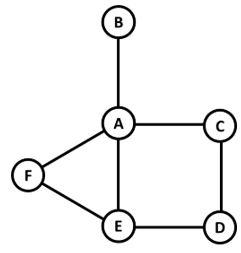
The teams need 30 minutes to cross a street connecting one police station to another. All four teams start from Station A at 09:00 hrs. and must return to Station A by 12:00 hrs. They can also pass via Station A at any point on their journeys.
The following facts are known.
1. None of the streets has more than one team traveling along it in any direction at any point in time.
2. Teams 2 and 3 are the only ones in stations E and D respectively at 10:00 hrs.
3. Teams 1 and 3 are the only ones in station E at 10:30 hrs.
4. Teams 1 and 4 are the only ones in stations B and E respectively at 11:30 hrs.
5. Team 1 and Team 4 are the only teams that patrol the street connecting stations A and E.
6. Team 4 never passes through Stations B, D or F.
Which one among the following stations is visited the largest number of times?
Video Explanation

Explanatory Answer

















How many times do the teams pass through Station B in a day?
Video Explanation

Explanatory Answer

















Which team patrols the street connecting Stations D and E at 10:15 hrs?
Video Explanation

Explanatory Answer

















How many times does Team 4 pass through Station E in a day?
Video Explanation

Explanatory Answer

















How many teams pass through Station C in a day?
Video Explanation

Explanatory Answer

















Let nn and mm be two positive integers such that there are exactly 41 integers greater than 8m8m and less than 8n8n, which can be expressed as powers of 2. Then, the smallest possible value of n +mn + m is
Video Explanation

Explanatory Answer
We need to have 41 integers that can be expressed as powers of 2 between 8m and 8n.
That is we need to have 41 integers that can be expressed as powers of 2 between 23m and 23n.
The numbers will be of the form: 23m,23n+1,23m+2,23m+3,…,23m+41,23n
clearly, 3n−1=3m+41
3(n−m)=42
n−m=14
The smallest value m
can take =1
, then n=15
m+n=1+15=16
The sum of the first two natural numbers, each having 15 factors (including 1 and the number itself), is
Video Explanation

Explanatory Answer

Rahul, Rakshita and Gurmeet, working together, would have taken more than 7 days to finish a job. On the other hand, Rahul and Gurmeet, working together would have taken less than 15 days to finish the job. However, they all worked together for 6 days, followed by Rakshita, who worked alone for 3 more days to finish the job. If Rakshita had worked alone on the job then the number of days she would have taken to finish the job, cannot be
Video Explanation

Explanatory Answer
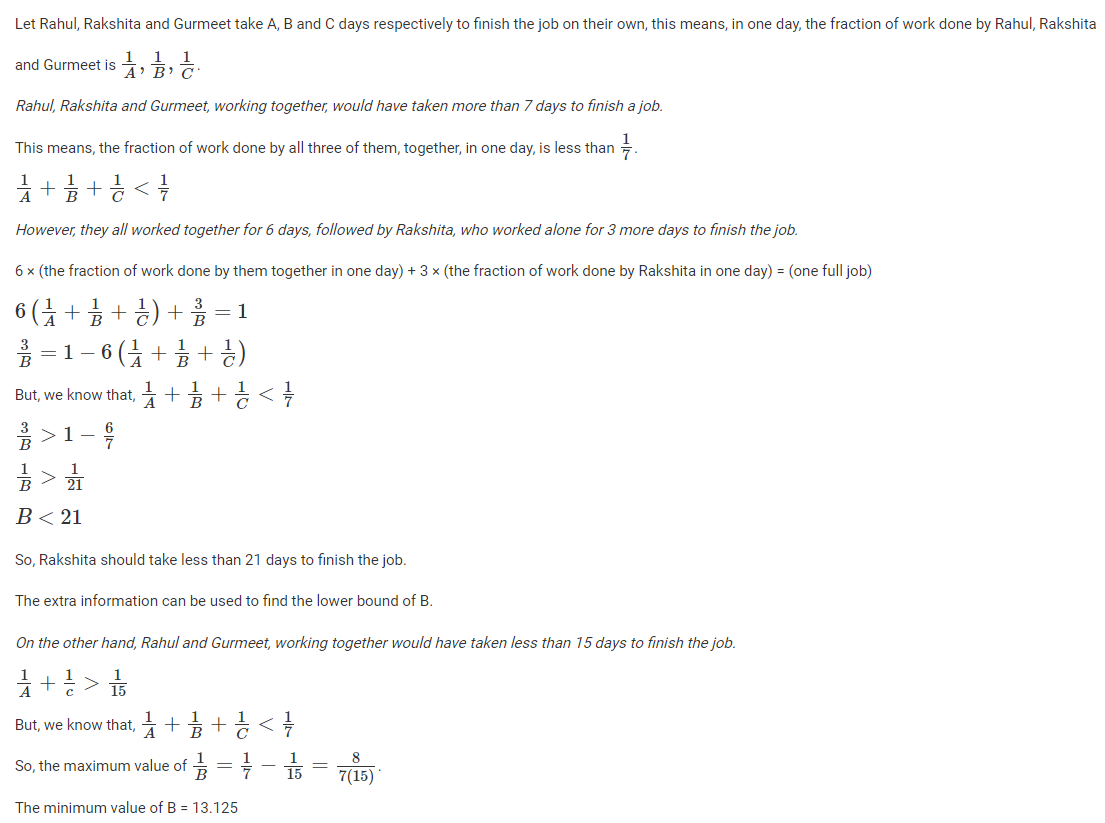
Anil mixes cocoa with sugar in the ratio 3 : 2 to prepare mixture A, and coffee with sugar in the ratio 7 : 3 to prepare mixture B. He combines mixtures A and B in the ratio 2 : 3 to make a new mixture C. If he mixes C with an equal amount of milk to make a drink, then the percentage of sugar in this drink will be
Video Explanation

Explanatory Answer
Mixture A and B are mixed in the ratio 2 : 3 to produce mixture C.
Let us assume that 20 kgs of mixture A is mixed with 30 kgs of mixture B to produce 50 kgs of mixture C.
Mixture A has cocoa and sugar in the ratio 3 : 2. This means, 20 kgs of mixture A contains 12 kgs of cocoa and 8 kgs of sugar. Mixture B has coffee and sugar in the ratio 7 : 3. This means, 30 kgs of mixture B contains 21 kgs of coffee and 9 kgs of sugar.
So, totally, 50kgs of mixture C has 17 kgs of sugar.
50 kgs of mixture C is mixed with 50 kgs of milk.
So, the percentage of sugar in the entire mixture =17/100×100=17%
The population of a town in 2020 was 100000. The population decreased by y% from the year 2020 to 2021, and increased by x% from the year 2021 to 2022, where x and y are two natural numbers. If population in 2022 was greater than the population in 2020 and the difference between x and y is 10, then the lowest possible population of the town in 2021 was
Video Explanation

Explanatory Answer
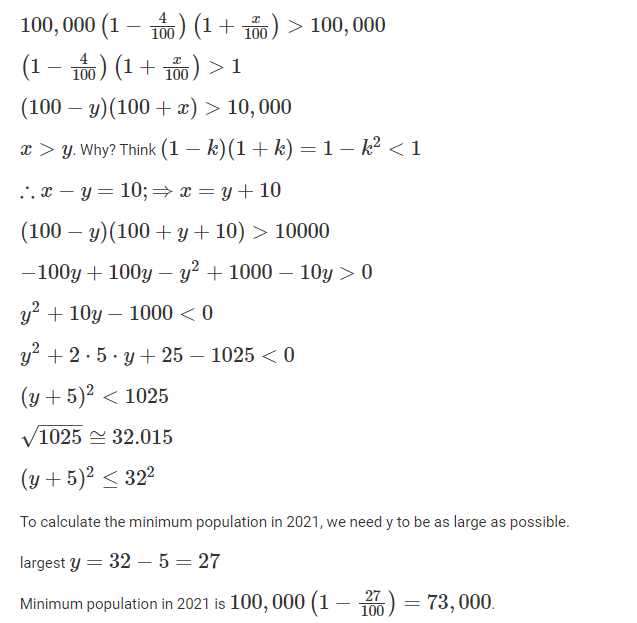
A merchant purchases a cloth at a rate of Rs.100 per meter and receives 5 cm length of cloth free for every 100 cm length of cloth purchased by him. He sells the same cloth at a rate of Rs.110 per meter but cheats his customers by giving 95 cm length of cloth for every 100 cm length of cloth purchased by the customers. If the merchant provides a 5% discount, the resulting profit earned by him is
Video Explanation

Explanatory Answer
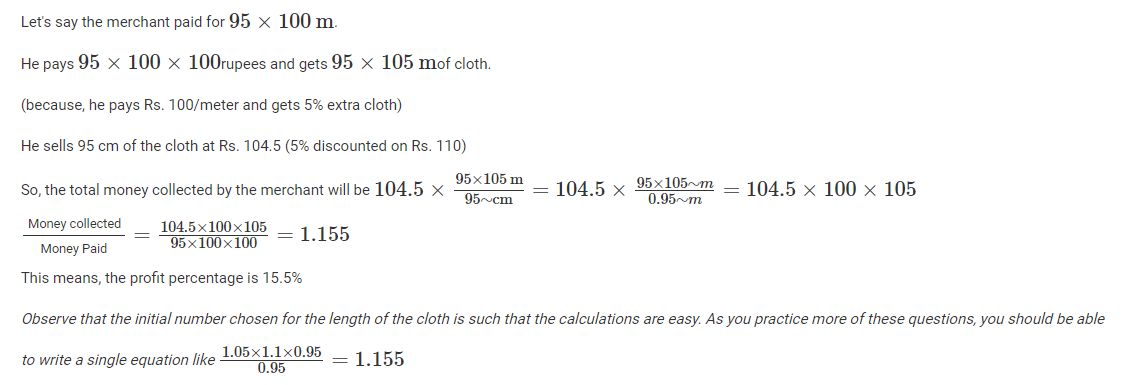
There are three persons A, B and C in a room. If a person D joins the room, the average weight of the persons in the room reduces by x kg. Instead of D, if person E joins the room, the average weight of the persons in the room increases by 2x kg. If the weight of E is 12 kg more than that of D, then the value of x is
Video Explanation

Explanatory Answer
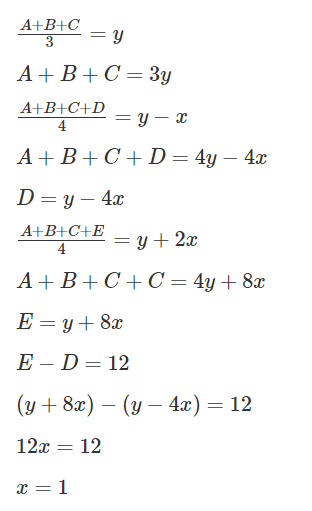
A boat takes 2 hours to travel downstream a river from port A to port B, and 3 hours to return to port A. Another boat takes a total of 6 hours to travel from port B to port A and return to port B. If the speeds of the boats and the river are constant, then the time, in hours, taken by the slower boat to travel from port A to port B is
Video Explanation

Explanatory Answer

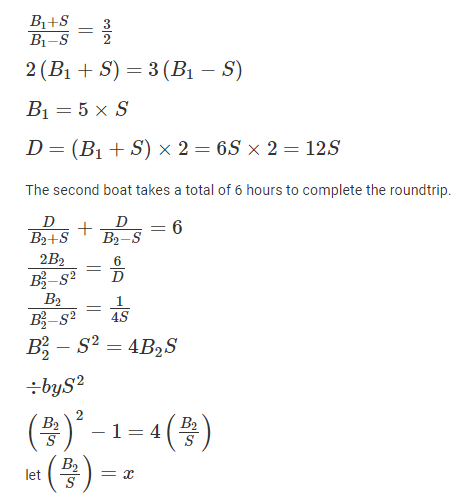
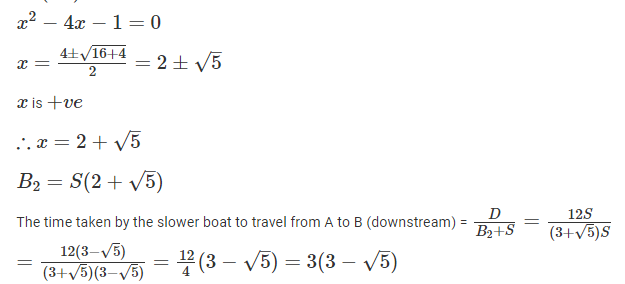
A fruit seller has a stock of mangoes, bananas and apples with at least one fruit of each type. At the beginning of a day, the number of mangoes make up 40% of his stock. That day, he sells half of the mangoes, 96 bananas and 40% of the apples. At the end of the day, he ends up selling 50% of the fruits. The smallest possible total number of fruits in the stock at the beginning of the day is
Video Explanation

Explanatory Answer

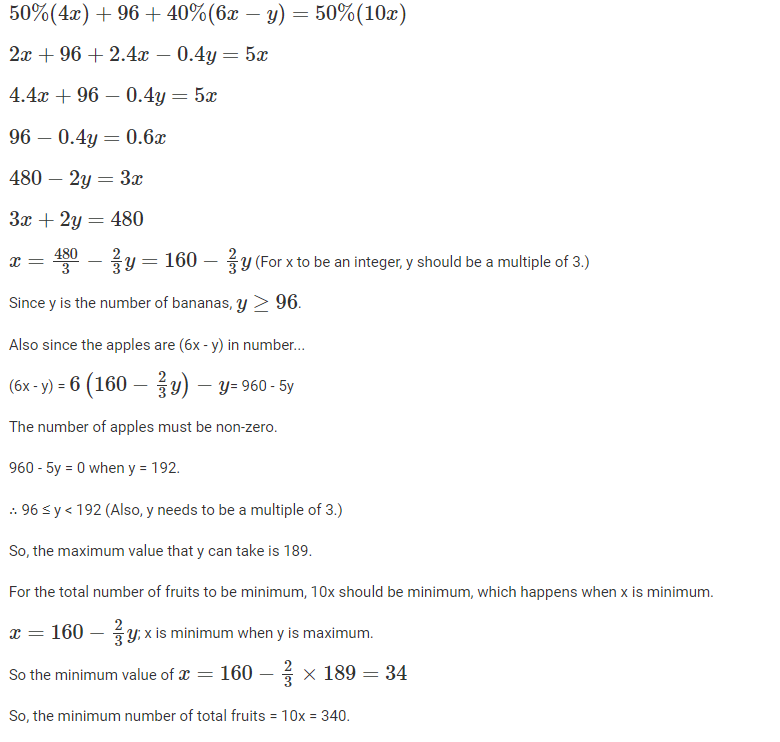
The number of coins collected per week by two coin-collectors A and B are in the ratio 3 : 4. If the total number of coins collected by A in 5 weeks is a multiple of 7, and the total number of coins collected by B in 3 weeks is a multiple of 24, then the minimum possible number of coins collected by A in one week is
Video Explanation

Explanatory Answer
Let the number of coins collected by A and B in one week be 3x and 4x respectfully.
The total number of coins collected by A in 5 weeks = 15x
For 15x to be a multiple of 7, x has to be a multiple of 7.
The total number of coins collected by B in 3 weeks = 12x
For 12x to be a multiple of 24, x has to be a multiple of 2.
Therefore, x has to be a multiple of 7 × 2 = 14
The minimum value that x can take is 14.
So, the minimum coins collected by A in one week = 3x = 3 × 14 = 42.
Gautam and Suhani, working together, can finish a job in 20 days. If Gautam does only 60% of his usual work on a day, Suhani must do 150% of her usual work on that day to exactly make up for it. Then, the number of days required by the faster worker to complete the job working alone is
Video Explanation

Explanatory Answer
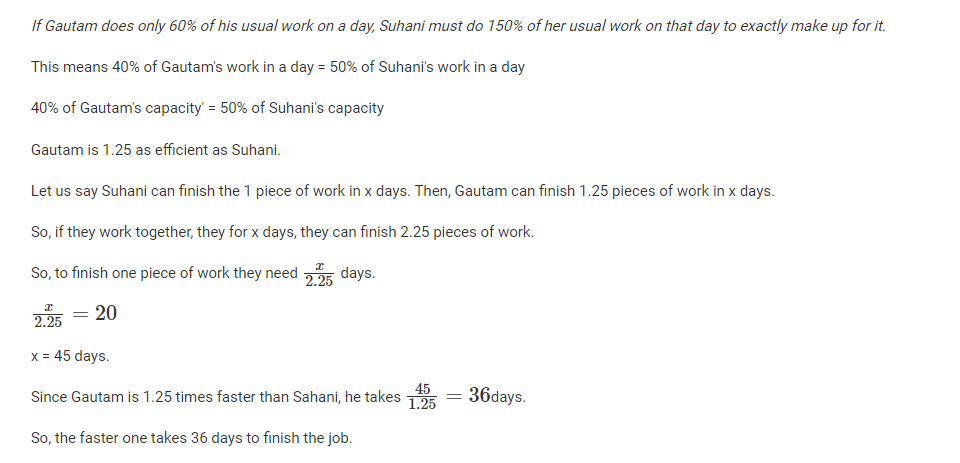
A rectangle with the largest possible area is drawn inside a semicircle of radius 2cm . Then, the ratio of the lengths of the largest to the smallest side of this rectangle is
Video Explanation

Explanatory Answer
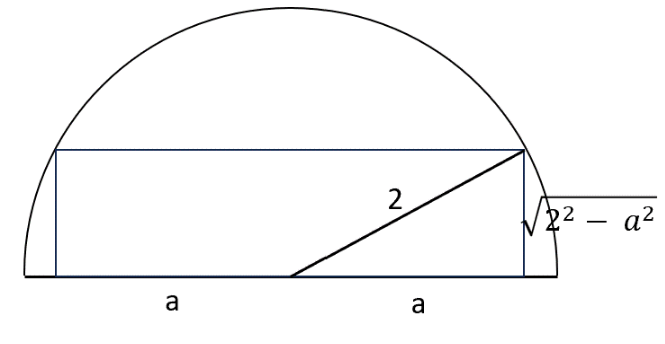
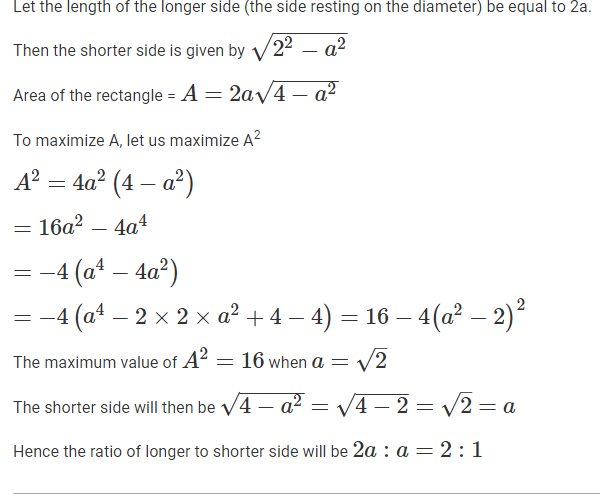
In a regular polygon, any interior angle exceeds the exterior angle by 120 degrees. Then, the number of diagonals of this polygon is
Video Explanation

Explanatory Answer
